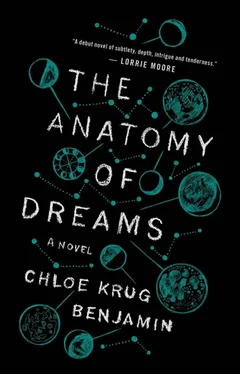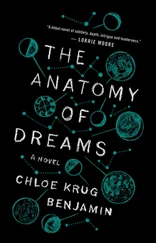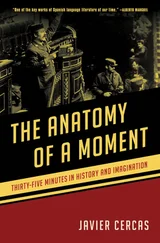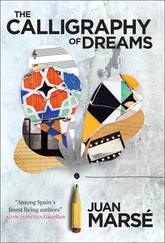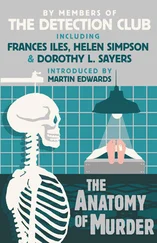As she showed us the photos, copies of which we’d already seen in her file in Snake Hollow, Anne was not emotional. In fact, whenever I saw her awake, she was restrained — delicate, perhaps, but with an inscrutable comportment that veiled whatever was going on inside her like the mess of a teenager’s room shoved underneath the bed: a haphazard method, but one that did make the floors look temporarily clean.
Gabe told me this was normal. “Most of our patients seem entirely sane when they’re awake,” he said as we packed up one day after a lucidity training session. “They’re mild mannered, sort of embarrassed — and they’re a lot more pleasant than she is, to be honest.”
The night before, Anne had slept at the lab during her first lucidity study. She seemed on edge when she arrived, and her mood worsened as we prepared her. She complained that the lab was too cold and then, when we turned the heat up, too warm; she had forgotten her usual Colgate toothpaste and refused to use the Crest we had in the lab, so I drove to the closest twenty-four-hour pharmacy. Because I was new, Gabe took Anne’s vitals and set up the video camera while Keller readied the EEG. I scarfed my dinner in Keller’s office. Minutes later, Gabe burst through the door.
“It’s bullshit,” he said. “Absolute bullshit. She said I touched her — inappropriately, that is. I was only trying to take her goddamn pulse.”
“What?” I put down my fork. “Did she know that was part of the procedure?” “Of course she did. Keller briefed her on the whole thing, just like usual. Thank God I already had the video running.”
That tape was enough to clear Gabe of any wrongdoing — it was obvious that he had affixed the straps exactly as we had been trained to do. But Anne’s accusation was enough to hint at what she would soon discover herself. She was a fantastically quick learner; participants were required to show signs of lucidity within six weeks if they were to continue in the study, but Anne was dreaming lucidly within the first three nights. She responded with the necessary left-right eye movements to our LEDs, though it was days before she would tell us what she’d seen.
“I think a part of me has always known,” she said. “But I never let myself think about it.”
We were in Keller’s office. Anne sat across from Keller, rigid-backed as a vigilant cat, one crossed leg twitching; I sat to Keller’s right, scribbling notes. Later, I would edit them for accuracy, sitting at the kitchen table with a tape recorder, pausing it every few seconds. When Keller told us, that day in Starbucks, that he had gotten rid of the files, this is what came to mind — not Anne, not her parents or sister, but those hours of meticulous work beneath the kitchen’s low bulb. The research was Keller’s, and Gabe assisted him during the trials. But it was my job to write our patients’ stories, and that work made me feel valuable. Even my parents could not deny that Keller’s research was intriguingly cutting-edge, and they slowly came to see my decision to leave Berkeley as evidence of my skill. It was a fib I told myself, too — that I had been chosen for my talent and not something else — but it kept me going.
It was easiest for me to do this transcription work alone. At night, after Gabe went to sleep, I sat at our rickety kitchen table with my headphones in and Keller’s tape recorder in my lap. Anne’s voice filled the room, ghostly and delicate as a night-blooming flower. When the interviews began, her tone was flat, but over the course of the session it became wispy and faltering. Always, though, there was an undercurrent of challenge, sharp and glinting like steel.
“Do you believe your sister to be at risk?” Keller asked once. His voice was clinical, impartial.
“Tell me, doctor,” said Anne, pronouncing the consonants with particular relish. “Do you?”
The dreams were not always the same, but they followed a reliable pattern. First, there was an image of trespass: a dog with hanging jowls pissing on a green lawn or a rat scurrying into a child’s bedroom. Next, Anne became conscious of her body in space. Sometimes she huddled in pillows, her limbs pretzeled into tight shapes. Other times, she found herself on the lawn of her childhood home, the stench of urine thick in the air. She experienced a growing sensation of defilement. She stood, her movements blundering but determined — it was only after Anne that we started to strap patients to the bed. At that point, it was only moments until she struck. Once, she pummeled the wall with such force that the skin ripped across her knuckles before Keller could stop her. After that, we had her wear thick, puffy gloves. Though she spoke of seeing a rat or a dog while dreaming, she always reported, upon waking, that she’d believed the animal to be her father. She reported, too, that she had gotten rid of him.
Within weeks, we learned to estimate the moment of her attack and flash the light stimulus right before it happened. If we could remind her that she was dreaming, we reasoned, we could help her intervene in her behavior before it turned violent. We were right: Anne paused in the room, dazed, and responded to the stimulus with the eye-movement signal we’d taught her. Then she returned to bed and woke out of slow-wave sleep about twenty minutes later.
It took months for Anne to reveal that she had suffered sexual abuse, that it had been at the hands of her father, and that she was worried for the life of her younger sister. Keller believed our study was giving her an opportunity to safely express her anger and process her impulses. He was electric: Anne became lucid more quickly than we’d ever seen before, and her reaction to the light stimulus was perfectly in line with his theory. He saw her as a landmark case, one that could be used to lobby for grant money and legitimize interactive lucid dreaming.
But we never saw Anne again. One day in late October, Gabe and I arrived at the lab to find Keller in his office, dazed and blinking, as if he’d just woken up.
“She’s pulled out,” he said. He nodded at the phone, its voice mail button red. “Listen.”
Anne rambled. She appreciated our time; she felt she had attained her goal, having seen what she’d been dreaming; and, having said as much, she felt no need to continue to participate in our study. She meandered for another minute or so — she could no longer afford the three-hour drive to Fort Bragg from San Francisco; gas prices being what they were; we understood, she was sure; $3.05 for a gallon of gas, not how it used to be; and that wasn’t counting the traffic —until Keller stopped the message.
I had never seen him so dejected; it was as if someone had died. Gabe, with characteristic brazenness, began to tease him.
“Cheer up, old chap,” he said, slapping Keller’s shoulder. “She’s just not the one for you. There’ll be other fish in the sea.”
Gabe and I were disappointed, too, but deep down we were grateful to be rid of Anne. She was crafty, unpredictable, and she had made us both uneasy. When I thought of her later, I felt a retrospective squirminess. It was like the memory of having accidentally eaten an insect: an ant on a bread roll, a spider in the salad.
That night, when we returned to the apartment, we buzzed with the wild, uninhibited energy of guests at a late-night wake. Our nervousness hung low in the room, sparking like power lines. Gabe rummaged around in the pantry until he found an old bottle of red wine. We drank, splayed on the couch, until we were more woozy than anxious.
“To Anne,” said Gabe.
“To Anne. May she sleep in peace.”
We clinked, then quieted. Had we let Anne down, or had she done that to us? She had weaseled out of our hands, disappeared through a crack in the wall. Though she had been the patient, we were the ones who felt exposed.
Читать дальше
